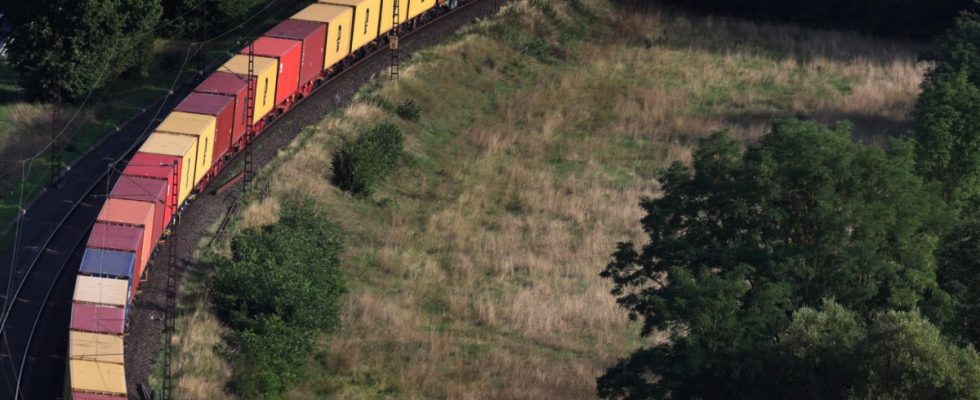“Drive or build?” Klaus-Dieter Josel asked himself this question this Monday. They then decided to build at Deutsche Bahn (DB). However, from 2026 onwards, there will be repeated standstills on important railway lines in the Free State for the general renovation of tracks, overhead lines, signaling technology, stations and whatever else is necessary to maintain railway traffic. Josel speaks of a “compromise” between what is feasible and what is reasonable. “There is no alternative to this approach,” says the DB Group representative for Bavaria. “We are falling behind in modernization.”
So: create and build routes. In order to resolve the renovation backlog in the railway network, the DB wants to renovate a number of corridors nationwide – central axes for passenger and freight transport. This will also lead to a number of restrictions and route closures in the Free State. How exactly is still unclear. Nevertheless, there is already great concern among private freight railways that the construction work could ultimately do them more harm than good.
DB man Josel is of course also aware of what he calls a “fundamental conflict” between driving and building. In the past, routes were often renovated during ongoing operations, he says. However, it would be more efficient to close the routes completely. “Five months,” Josel calculates for each construction project. And according to the planning status, there will be seven of them in Bavaria. The route from Nuremberg to Regensburg will begin in February 2026. In the second half of the year, the section between Obertraubling and Passau south of Regensburg will be closed and overhauled. The tracks between Munich, Rosenheim and Salzburg will follow in 2027 and those between Würzburg and Nuremberg in 2028. At best, the Würzburg-Ansbach-Treuchtlingen and Ulm-Augsburg routes complete the route.
If you add up all the routes, you get a good 700 kilometers that will be affected by construction projects. The further details will now be worked out in the next few months. For local transport, rail replacement services by bus should be part of the standard repertoire. However, important junctions such as the Regensburg and Rosenheim train stations should largely be spared from the measures; the matter is already complicated enough. In order to inform people, a separate website about the construction projects is also planned – and an “information tour” through the affected regions.
One of the biggest points of contention, however, is how to deal with the route between Obertraubling and Passau. It is of particular importance for freight transport, as it creates a connection via Nuremberg between the North Sea ports on the one hand and Austria, Hungary and the Balkan states on the other. The route is also interesting for international passenger traffic. However, the travel speeds and capacities are too low in many places for such an important axis, the Chamber of Commerce and Industry in Regensburg stated in a report in 2020. In the long term, there is a need for, among other things, “needs-based upgrading of the topographically difficult section” between Regensburg and Passau. The DB also considers restructuring to be unavoidable. Among other things, stations, tracks, signal box technology and overhead lines need an update. The rail lines near Osterhofen present an additional challenge, where boggy ground needs to be fortified so that trains can pass faster again.
“Not building is not an alternative at all”
“Not building is not an alternative at all,” confirms Peter Westenberger. However, the managing director of the Association of Freight Railways expressed skepticism over the phone as to whether a complete closure for months would be necessary for every route renovation. Above all, he fears that the freight railway companies could be forced to take large-scale detours if the route between Obertraubling and Passau were closed. The rail infrastructure in the region has been “so thinned out” that there are hardly any alternatives. The result, according to Westenberger: part of the transport of goods could shift to the road. And not just during the construction work, but permanently, as examples from other countries show. Many freight railways are already struggling financially.
In fact, the alternative options in Eastern Bavaria are manageable. A route currently being discussed could start behind Nuremberg and lead there via the Czech Republic to Vienna. From there you can either continue to Hungary – or back to Wels, Linz and Passau. According to calculations by the freight railway association, the trains would have to travel around 200 kilometers more than usual. There are shorter alternatives: Accordingly, the Nuremberg-Munich-Salzburg route would mean a detour of “only” 160 kilometers. The problem: The tracks there are considered overloaded. And parts of passenger transport will probably have to push through this bottleneck like other bottlenecks.
Those responsible at Deutsche Bahn point out that the planning for the so-called diverters has not been completed. How the alternative traffic will ultimately work cannot be said at this point in time; more coordination is needed: on the one hand with the Czech Republic and on the other hand with the freight railways. Their concerns have to be taken seriously, says Josel. However, also: “We have to build so that we can drive.”
Because driving in the Free State already causes enough problems. Also on Monday, the Bavarian Railway Company (BEG) announced that last year only 87 percent of regional trains and S-Bahn trains were on time – that is, they arrived less than six minutes late. Another 6.3 percent of the connections even failed completely. According to the BEG, the punctuality rate fell to a historic “low since the railway reform in the 1990s”. The most common reason for the delays and cancellations: “Restrictions due to the often dilapidated railway infrastructure”.

